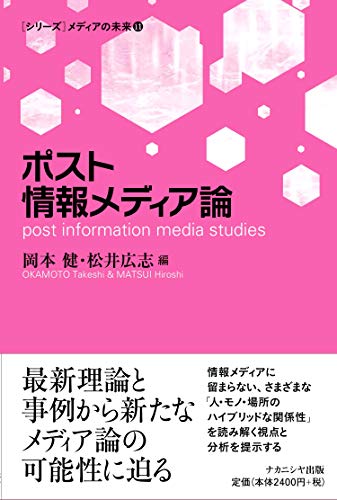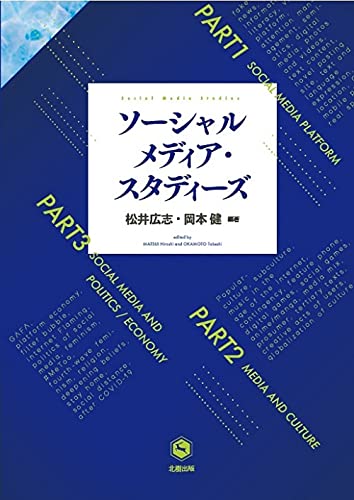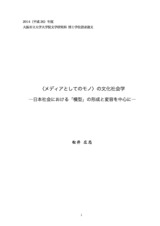32 0 0 0 OA メディア論、メディア表現とファン文化報告書 : MANGAlabo 7公開ワークショップ
- 著者
- スタインバーグ マーク エルネスト・ディ・アルバン エドモン 須川 亜紀子 松井 広志 エルナンデス・エルナンデス アルバロ・ダビド
- 出版者
- 国際日本文化研究センタープロジェクト推進室
- 雑誌
- メディア論、メディア表現とファン文化報告書 : MANGAlabo 7公開ワークショップ
- 巻号頁・発行日
- pp.1-71, 2021-03-27
現代日本の大衆文化の一種であるアニメやマンガが益々注目を集める中、同人誌やコスプレなどのように、このメディア文化を中心にして行われる活動にも注目が集まっている。アニメやマンガといったメディア表現とファン文化を考える際、「商品と消費者」という単純な構造を超え、メディアの性質とその発展、メディア表現の特徴や我々がどのようにメディアと付き合うのかを、考える必要がある。この公開ワークショップにおいては、最先端のメディア論を踏まえ、3名の講師から現代日本の大衆文化におけるメディア表現とメディア使用の接点について学ぶ。
17 0 0 0 ポスト情報メディア論
8 0 0 0 ソーシャルメディア・スタディーズ
- 著者
- 松井広志 岡本健編著
- 出版者
- 北樹出版
- 巻号頁・発行日
- 2021
- 著者
- 松井 広志 Hiroshi Matsui
- 出版者
- 関西学院大学先端社会研究所 ; 2012-
- 雑誌
- KG社会学批評 = KG sociological review (ISSN:21870683)
- 巻号頁・発行日
- no.1, pp.109-119, 2012-03
- 著者
- 松井 広志 井口 貴紀 大石 真澄 李 天能
- 出版者
- [愛知淑徳大学] 創造表現学部論集編集委員会
- 雑誌
- 愛知淑徳大学論集. 創造表現学部篇 = Bulletin of Aichi Shukutoku University. [愛知淑徳大学] 創造表現学部論集編集委員会 編
- 巻号頁・発行日
- no.7, pp.23-38, 2017
4 0 0 0 IR 多元化するゲーム文化の研究課題 : 利用と満足・ゲーム実践・メタゲーム
- 著者
- 松井 広志 井口 貴紀 大石 真澄 李 天能
- 出版者
- 愛知淑徳大学創造表現学部論集編集委員会
- 雑誌
- 愛知淑徳大学論集. 創造表現学部篇 (ISSN:21862265)
- 巻号頁・発行日
- no.7, pp.23-38, 2017-03-15
- 著者
- 松井 広志
- 出版者
- 日本マス・コミュニケーション学会
- 雑誌
- マス・コミュニケーション研究 (ISSN:13411306)
- 巻号頁・発行日
- vol.87, pp.77-95, 2015
The aim of this paper is to study the materiality of media through the experiential analysis of the history of model kits in Japan. The authors focus on the following questions: "What is materiality of media?" and "How are materiality and intermediacy related to each other?" Answering these questions requires hypothesis development for theoretical considerations based on experiential analysis of a specific medium that has materiality as its essential element. In this study, the authors examine the history of model kits in Japan. This paper analyzes the history of model kits in Japan from the 1900s through the 1960s by using a variety of materials, which include miniature model products, miniature model magazines, statistical data and yearbooks of related companies. The authors' findings show that different media were created in different periods: scientific miniature models that mediated the future before World War II; armament models that mediated the present during World War II; and scale models during the post-war period of rapid economic growth. At the same time, the creation of these media was inextricably connected with materials, such as wood, metals, substitute materials, and plastic. However, these materials and models were originally not separate entities but represented different aspects of a single medium. In other words, scientific models were the same medium as models made of wood and metals; armament models were inseparable from substitute materials; and scale models were the same as plastic models. As these examples show, analyzing the creation of media, including actors (materials), leads us to reconsider the deterministic understanding of the essence of a medium. These considerations led to the following conclusion regarding the materiality of media: Specific materials are used to form a specific medium and the resulting materiality creates dynamic changes in the intermediacy of the medium. Inversely, a medium appears to have diachronic identity due to the inextricable connection between the materiality and intermediacy of the medium, which causes its different elements to form a specific area as a group despite the variability of individual elements.
4 0 0 0 OA ポピュラーカルチャーにおけるモノ
- 著者
- 松井 広志
- 出版者
- 日本社会学会
- 雑誌
- 社会学評論 (ISSN:00215414)
- 巻号頁・発行日
- vol.63, no.4, pp.503-518, 2013-03-31 (Released:2014-03-31)
- 参考文献数
- 48
近年, デジタルメディアによるコンテンツ受容に関して, 「物質」の対概念としての「情報」そのものに近い消費のあり方が伺える. しかし, ポピュラーカルチャーの現場では, 物質的な「モノ」という形式での受容が依然として観察される. ここには「ポピュラーカルチャーにおけるモノをめぐる人々の活動」という論点が潜んでいる. 本稿の目的は, この受容の論理を多面的な視点から, しかも日常的な実感に即して読み解くことである. 本稿ではその動向の典型を, ポピュラーカルチャーのコンテンツを題材としたキャラクターグッズやフィギュア, 模型やモニュメントに見出し, これらを「モノとしてのポピュラーカルチャー」と理念的に定義したうえで, 3つの理論的枠組から捉えた.まず, 従来の主要な枠組であった消費社会論から「記号」としてのモノの消費について検討した. 次に, 空間的に存在するモノを捉える枠組として物質文化論に注目し, とくにモノ理論から「あるモノに固有の物質的な質感」を受容する側面を見出した. さらに, モノとしてのポピュラーカルチャーをめぐる時間的側面を, 集合的記憶論における「物的環境による記憶の想起」という枠組から捉えた. これらの総合的考察から浮かび上がった「モノとしてのポピュラーカルチャー」をめぐる人々の受容の論理は, 記号・物質・記憶のどれにも還元されず, 時間的・空間的に重層化した力学の総体であった.
4 0 0 0 IR 記憶・フィギュア・ミュージアム : 「海洋堂フィギュアミュージアム黒壁 龍遊館」を中心に
- 著者
- 松井 広志
- 雑誌
- 持続可能な文化アーカイブ研究会 活動報告書
- 巻号頁・発行日
- pp.34-41, 2011-03
3 0 0 0 OA 物語・記憶・擬似アウラ : 「実物大ガンダム」の〈魅力〉と物質性をめぐる考察
- 著者
- 松井 広志 Hiroshi Matsui
- 雑誌
- KG社会学批評 : KG Sociological Review (ISSN:21870683)
- 巻号頁・発行日
- no.創刊号, pp.109-119, 2012-03-10
3 0 0 0 OA 〈メディアとしてのモノ〉の文化社会学 : 日本社会における「模型」の形成と変容を中心に
- 著者
- 松井 広志
- 出版者
- 日本マス・コミュニケーション学会
- 雑誌
- マス・コミュニケーション研究 (ISSN:13411306)
- 巻号頁・発行日
- vol.98, pp.19-32, 2021
<p>This paper examines video games in order to discuss roles played by media culture during the COVID-19 pandemic. In 2020, people spent a large amount of their time playing communication-oriented games, such as "Animal Crossing: New Horizons," or social multiplayer games on smartphones. This trend is an extension of the casual revolution in video games since the 2000s.</p><p>Notably, however, communication-oriented games during the pandemic also seem to offer alternative means for casual ordinary communication in the abnormal reality imposed by the pandemic. Their popularity is a sign of new roles played by media culture and games.</p>
- 著者
- 松井 広志
- 出版者
- 日本マス・コミュニケーション学会
- 雑誌
- マス・コミュニケーション研究 (ISSN:13411306)
- 巻号頁・発行日
- vol.93, pp.145-146, 2018
2 0 0 0 ポピュラーカルチャーにおけるモノ:記号・物質・記憶
- 著者
- 松井 広志
- 出版者
- 日本社会学会
- 雑誌
- 社会学評論 (ISSN:00215414)
- 巻号頁・発行日
- vol.63, no.4, pp.503-518, 2013
近年, デジタルメディアによるコンテンツ受容に関して, 「物質」の対概念としての「情報」そのものに近い消費のあり方が伺える. しかし, ポピュラーカルチャーの現場では, 物質的な「モノ」という形式での受容が依然として観察される. ここには「ポピュラーカルチャーにおけるモノをめぐる人々の活動」という論点が潜んでいる. 本稿の目的は, この受容の論理を多面的な視点から, しかも日常的な実感に即して読み解くことである. 本稿ではその動向の典型を, ポピュラーカルチャーのコンテンツを題材としたキャラクターグッズやフィギュア, 模型やモニュメントに見出し, これらを「モノとしてのポピュラーカルチャー」と理念的に定義したうえで, 3つの理論的枠組から捉えた.<br>まず, 従来の主要な枠組であった消費社会論から「記号」としてのモノの消費について検討した. 次に, 空間的に存在するモノを捉える枠組として物質文化論に注目し, とくにモノ理論から「あるモノに固有の物質的な質感」を受容する側面を見出した. さらに, モノとしてのポピュラーカルチャーをめぐる時間的側面を, 集合的記憶論における「物的環境による記憶の想起」という枠組から捉えた. これらの総合的考察から浮かび上がった「モノとしてのポピュラーカルチャー」をめぐる人々の受容の論理は, 記号・物質・記憶のどれにも還元されず, 時間的・空間的に重層化した力学の総体であった.
2 0 0 0 OA 近代日本の手作りとジェンダー -大量生産の時代における趣味のジェンダー化-
- 著者
- 神野 由紀 辻 泉 山崎 明子 溝尻 真也 中川 麻子 飯田 豊 塩谷 昌之 塩見 翔 松井 広志 佐藤 彰宣 今田 絵里香
- 出版者
- 関東学院大学
- 雑誌
- 基盤研究(C)
- 巻号頁・発行日
- 2015-04-01
大量生産の既製品が安易に購入できるようになった20世紀半ば、自己表現としての手作りが大衆化していく。本研究では雑誌調査などから、女性の手芸に対して男性は工作と呼ばれる手作り趣味が興隆した背景を明らかにした。男女の手作りは近代的なジェンダーの枠組みの中で、それぞれの領域を発展させていった。両者の関係は女性解放運動の影響、あるいは男性の家庭生活への接近などにより揺れ動きつつも、それを完全に越境することが困難な時代が続いた。しかし今日、こうしたジェンダーの枠組みを超えるような新たな手作りの文化も生まれてきていることも明らかになった。
2 0 0 0 OA メディアの物質性と媒介性 : 模型史からの考察(<特集>メディアの物質性)
- 著者
- 松井 広志
- 出版者
- 日本マス・コミュニケーション学会
- 雑誌
- マス・コミュニケーション研究 (ISSN:13411306)
- 巻号頁・発行日
- no.87, pp.77-95, 2015-07-31
The aim of this paper is to study the materiality of media through the experiential analysis of the history of model kits in Japan. The authors focus on the following questions: "What is materiality of media?" and "How are materiality and intermediacy related to each other?" Answering these questions requires hypothesis development for theoretical considerations based on experiential analysis of a specific medium that has materiality as its essential element. In this study, the authors examine the history of model kits in Japan. This paper analyzes the history of model kits in Japan from the 1900s through the 1960s by using a variety of materials, which include miniature model products, miniature model magazines, statistical data and yearbooks of related companies. The authors' findings show that different media were created in different periods: scientific miniature models that mediated the future before World War II; armament models that mediated the present during World War II; and scale models during the post-war period of rapid economic growth. At the same time, the creation of these media was inextricably connected with materials, such as wood, metals, substitute materials, and plastic. However, these materials and models were originally not separate entities but represented different aspects of a single medium. In other words, scientific models were the same medium as models made of wood and metals; armament models were inseparable from substitute materials; and scale models were the same as plastic models. As these examples show, analyzing the creation of media, including actors (materials), leads us to reconsider the deterministic understanding of the essence of a medium. These considerations led to the following conclusion regarding the materiality of media: Specific materials are used to form a specific medium and the resulting materiality creates dynamic changes in the intermediacy of the medium. Inversely, a medium appears to have diachronic identity due to the inextricable connection between the materiality and intermediacy of the medium, which causes its different elements to form a specific area as a group despite the variability of individual elements.
1 0 0 0 IR <メディアとしてのモノ>の文化社会学 : 日本社会における「模型」の形成と変容を中心に
- 著者
- 木澤 俊和 川又 修一 鈴木 貴博 根岸 栄一 松井 広志 豊田 直樹 石田 武和
- 出版者
- 一般社団法人日本物理学会
- 雑誌
- 日本物理学会講演概要集 (ISSN:13428349)
- 巻号頁・発行日
- vol.60, no.1, 2005-03-04




